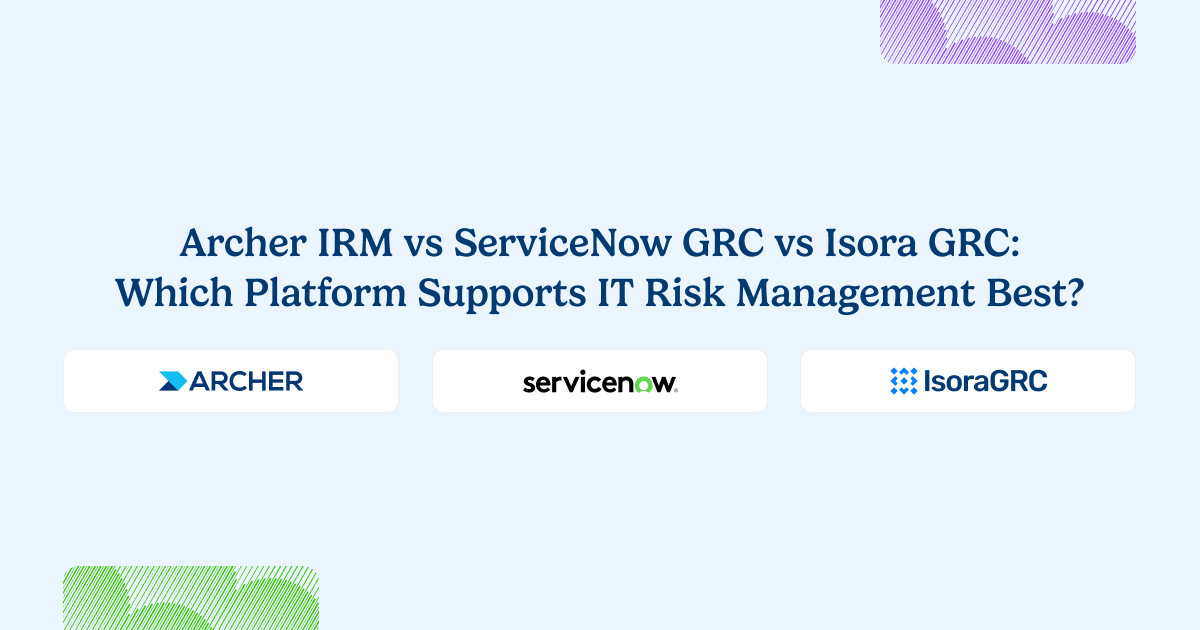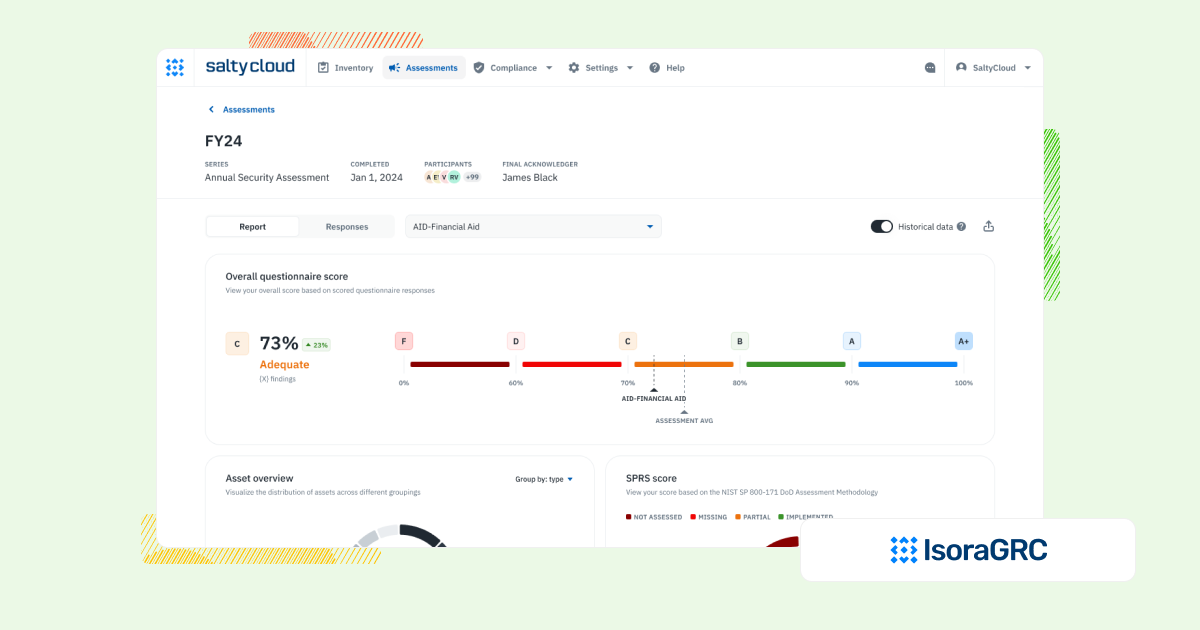
Every security team needs a reliable, collaborative way to manage IT risk—without navigating layers of complexity.
Archer IRM and ServiceNow GRC are both all-in-one GRC platforms designed for enterprise-wide governance. They offer robust configurability and broad compliance coverage, but for security teams, they often come at the cost of usability, speed, and adoption.
When tools are built to serve everyone, they rarely work well for the people managing risk every day. From long setup cycles to disjointed modules and steep learning curves, these platforms can make it harder—not easier—to assess risk, manage inventories, or track exceptions at scale.
Isora GRC takes a different approach. It’s purpose-built for information security teams, offering the structure and clarity needed to run assessments, manage risk registers, and collaborate across the organization—without the overhead of traditional GRC suites.
Let’s take a closer look.
Choosing the Right Platform for IT Risk Management
Archer IRM and ServiceNow GRC are powerful platforms with broad use cases across audit, compliance, and enterprise risk. But their strength in configurability often comes with tradeoffs: complex deployments, heavy IT involvement, and workflows that don’t reflect how security teams operate day to day.
Isora GRC is designed for the people actually doing the work of managing IT and vendor risk. It delivers structured, repeatable workflows—assessments, inventories, exception tracking, and risk registers—through a platform that’s easy to use, fast to deploy, and built for adoption across the organization.
The Workflow That Matters: Managing IT Risks and Compliance
Managing IT risk is an ongoing process that touches every part of the organization. It involves issuing assessments to internal teams and vendors, maintaining asset and vendor inventories, identifying and tracking risks, and engaging stakeholders in remediation.
This work demands clarity, coordination, and flexibility—traits that bloated, general-purpose GRC platforms often struggle to provide. Disconnected modules, confusing interfaces, and overengineered features make it harder for security teams to move quickly or stay aligned.
Isora GRC brings these workflows together in one place. It’s designed to help security teams operationalize risk—not configure around it.
How Each Platform Supports IT Risk Management Workflows
| Workflow Area | Archer IRM | ServiceNow GRC | Isora GRC |
| Assessment Management | Document-driven approach with complex approval workflows. Requires specialized resources and extensive professional services to implement properly. | ServiceNow GRC handles assessments, but setup takes time. Custom changes need skilled help, which can slow things down and raise costs. | Centralized, intuitive assessment dashboard across business units, vendors, and assets. Built specifically for security teams. |
| Questionnaire Delivery & Completion | Limited questionnaire capabilities that require extensive configuration. Not designed for end-user completion, requiring technical mediators. | Survey tools work, but the layout feels clunky for new users. Learning takes time, and some teams may avoid using the tools. | Customizable and prebuilt questionnaires for frameworks like NIST, ISO, GLBA, HIPAA, and more. Designed for internal and external collaboration. |
| Inventory Tracking | Advanced risk register requiring specialized knowledge with formal signoff processes that create bottlenecks. Exception governance managed through multiple modules requiring integration. | Connecting ServiceNow GRC to old systems brings trouble. Upgrades may cost extra and slow the shift to the new system. | Centralized tracking of assets, vendors, and organizational units with integration support for existing data sources. |
| Risk Register & Exception Management | Powerful but complex reporting capabilities requiring significant consultant hours to set up. Difficult to modify without specialized knowledge. | Risk and exception tools run strong, but setup stays tough. Managing these tools may need extra teams, pulling time and money. | Flexible, collaborative risk register with scoring, status, evidence, and ownership tied directly to assessments. Exception management is built-in and intuitive—no extra modules or configuration required. |
| Scoring, Reporting & Risk Visualization | Advanced reporting with heat maps but requires manual configuration for executive use. Reports often require technical expertise to create and modify. | Reports in ServiceNow can be tricky. Pulling data from different sources and making custom reports takes effort. This may slow down decisions. | Automated scorecards, risk maps, and executive-friendly reports with actionable insights—no manual config required. |
| Collaboration & User Experience | Steep learning curve with overwhelming interface. Collaboration through “Archer Engage” but lacks intuitive discussion tools. Most users need extensive training. | The layout feels heavy and hard to use. Learning takes time, so teams may need extra training to feel confident. | WCAG-compliant, award-nominated interface with built-in commenting, team workflows, and fast onboarding. |
| Implementation & Setup | Implementation typically takes months to years with specialized resources. High total cost of ownership with significant consulting and internal resource requirements. | Setting up ServiceNow GRC takes time, people, and money. License costs run high. Old systems may block a smooth shift and force more tech upgrades. | No-code setup in days or weeks. Minimal IT lift required. Designed to go live quickly across teams and vendors. |
What Sets Isora GRC Apart?

Isora GRC was purpose-built for information security teams—designed to support the real workflows behind risk and compliance, not just generate reports. While legacy GRC platforms require months of configuration and rigid processes, Isora takes a modern, scalable approach:
- Purpose-built for security and third-party risk teams
- No extra modules or cross-department bloat—just the workflows that matter.
- Easy for anyone to use
- Clean UI, no complex training, and built to drive adoption across the org.
- Streamlined for action, not just documentation
- Assessments, questionnaires, inventories, risk tracking, and reporting—all in one place.
- Fast, no-code implementation
- Go live in weeks, not quarters, with minimal IT lift.
- Scales with your program
- Whether you’re running a lean risk function or supporting a large institution, Isora grows with you—without getting in the way.
Who Each Platform Is Best For
| Platform | Who It’s For |
| Archer IRM | Large businesses, especially in finance or government that need custom tools to track risk and follow strict rules. |
| ServiceNow GRC | Companies already using ServiceNow. Helps tie risk and compliance into other business tools, but often feels built more for IT than security. |
| Isora GRC | Security teams that need a scalable, usable IT risk management program across their organization. |
What Our Customers Say About Isora GRC
Security teams at top institutions are using Isora GRC to replace legacy tools and manual processes with intuitive workflows and actionable insight.
“Moving from manual processes to using Isora was a breath of fresh air. What used to take months is now automated, reliable, and defensible. Isora saves us significant time while delivering accurate insights that improve decision-making.”
Jessica Sandy, IT GRC Manager, The University of Chicago
“Isora has been essential in helping us meet our University of California cybersecurity requirements across a decentralized campus. Automating assessment data collection and reporting has given us clear visibility into unit-level risks, enabling us to prioritize resources effectively and address gaps with confidence.”
Allison Henry, CISO, The University of California, Berkeley
FAQs
What’s the difference between Archer IRM, ServiceNow GRC, and Isora GRC?
Archer IRM and ServiceNow GRC are part of the all-in-one GRC category, offering broad enterprise functionality. Isora GRC is purpose-built for information security teams—streamlining assessments, inventories, and risk tracking without the complexity of multi-department GRC platforms.
Are Archer IRM and ServiceNow GRC considered all-in-one GRC platforms?
Yes. Both are built to support a wide range of risk, audit, and compliance functions across departments. That breadth can come at the cost of usability for security teams focused specifically on IT risk.
Does Isora GRC replace tools like Archer or ServiceNow, or does it complement them?
Isora GRC can replace all-in-one GRC platforms when teams want a simpler, more usable way to manage assessments, asset inventories, and IT risk. Some organizations may still pair Isora with legacy systems when broader governance features are required.
Which platform is best for managing IT risk across the organization?
Archer and ServiceNow provide configurable enterprise workflows, but can be heavy to implement. Isora GRC supports security teams with intuitive tools to manage IT and vendor risk end-to-end—built for adoption, not just configuration.
Do I still need my enterprise GRC platform if I use Isora GRC?
It depends. Many organizations use Isora GRC to replace heavier platforms for IT and vendor risk. Others keep their enterprise GRC for legal or audit functions, while using Isora to drive day-to-day security risk workflows.
What should I look for in a GRC platform for IT risk management?
Look for fast deployment, collaboration, and ease of use. IT risk is a team sport—your platform should support assessments, questionnaires, inventories, and real-time risk tracking across technical and business users.



















 Other Relevant Content
Other Relevant Content